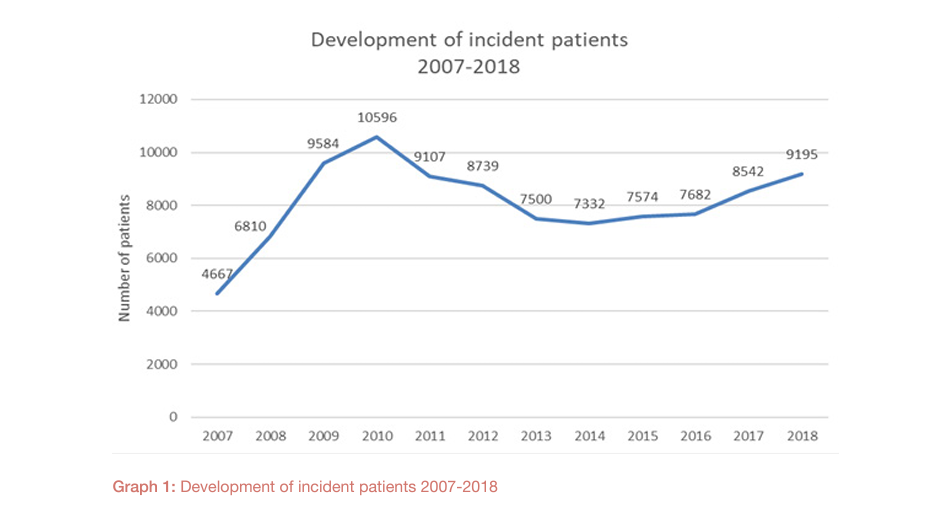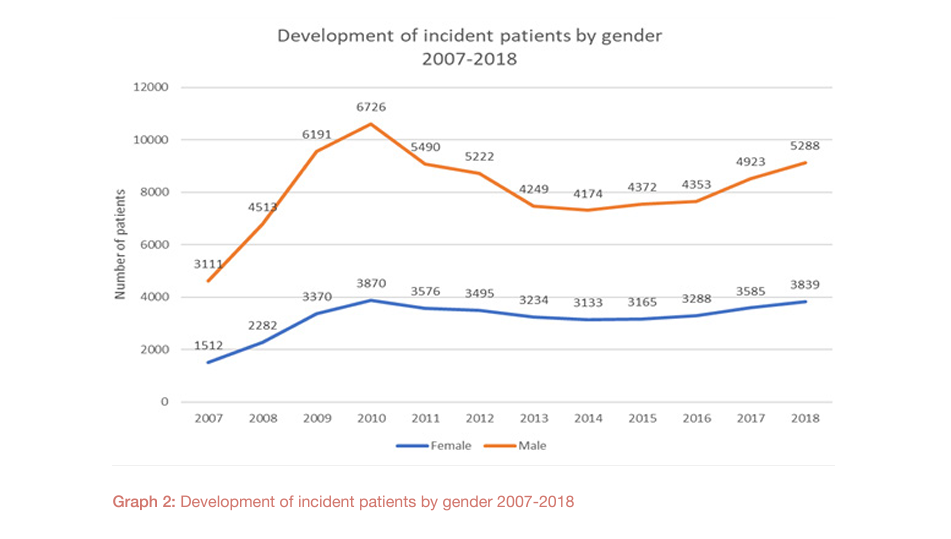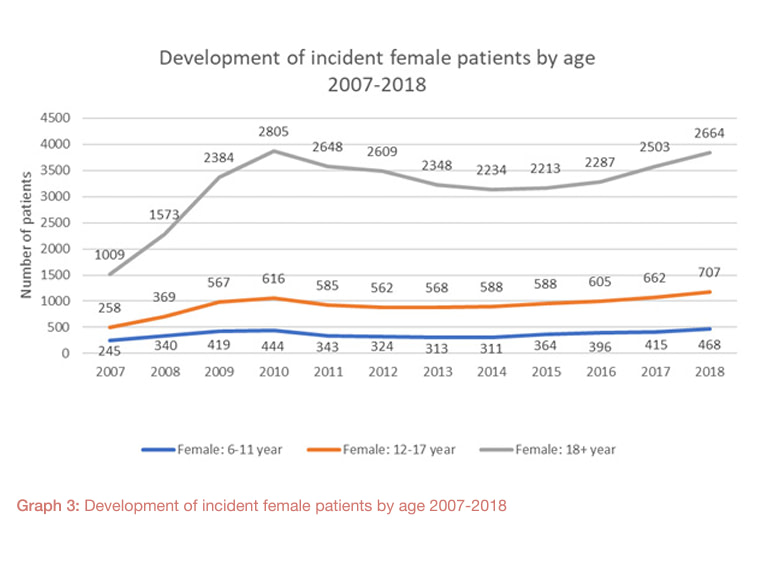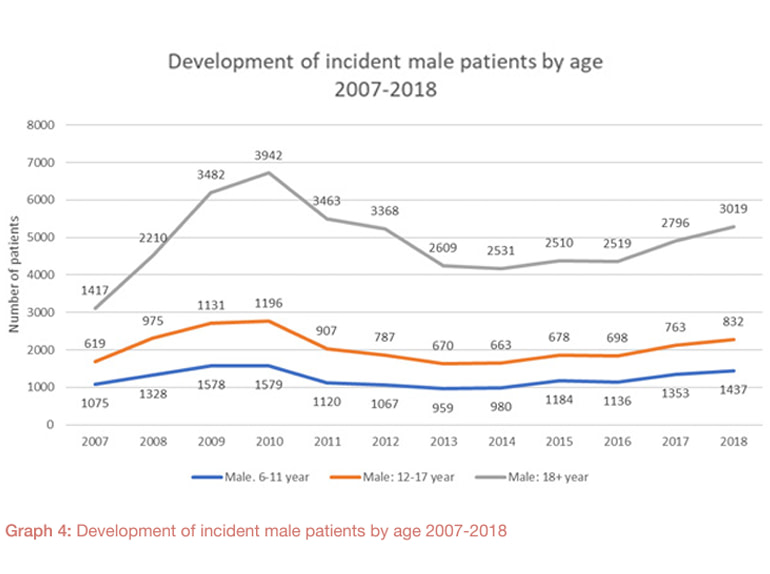
Case
Trends in medical treatment for ADHD among Danish incident patients based on real world data
Analysis institute: Signum Life Science
Background
On behalf of Medice Nordic Denmark ApS, Signum Life Science has conducted a real-world data (RWD) analysis of the trends in the medical treatment for attention deficit hyperactivity disorder (ADHD).
ADHD is a lifelong disease that potentially requires lifelong medical treatment. Information on how ADHD differs within gender and age groups is relevant information for authorities and prescribers as this presents descriptive information on how the patient population treated for ADHD looks like – and as it may indicate whether treatment guidelines are being followed by prescribers.
The purpose of the analysis was to describe and map the development and characteristics of the patient population receiving medical treatment for ADHD between 2007-2018.
Below we highlight a selection of the findings from the analysis; namely the development in the incident patients in Denmark according to age and gender. To our knowledge statistics describing the development of this patient group (i.e. incident patients) between 2007 and 2018 is not available in the public domain. We believe this information may be relevant to psychiatrists, general practitioners, policymakers or other professionals within the area.
Methods
Period of analysis: 2007-2018
Statistics and analysis
The analysis is based on patient data from the Danish National Prescription Registry (DNPR). While aggregated data on drug sales and number of patients are publicly available via Medstat.dk, description of drug use among incident patients is not available (Pottegård et al., 2017). As DNPR is protected by GPDR legislation, Statistics Denmark (DST) forms an aggregated dataset to ensure full patient anonymization. The aggregated dataset is transferred in Excel for further interpretations and analysis by Signum. The results are a descriptive analysis of variable combinations in Excel cross tables and illustrations of striking data trends.
Population
A patient is defined as incident at date of first prescription redemption for ADHD medication.
Socio demographic variables
- Socio demographic patient characteristics covers age and gender.
- Age is defined at first redemption of ADHD medication.
- Gender is defined by interpreting the last two personal record numbers.
Findings
Number of incident patients
In 2018 9,195 incident patients redeemed a prescription for ADHD medication. Looking at the development, the patient number has close to doubled during the period of analysis – from 4,667 in 2007 to 9,195 in 2018. See graph 1. The increase in this period (2007-2018) took however place during the first 3 years. From 2010 to 2018 no increase has been observed.

Developments in the population
During the first years of the study period the number of incident patients increased noticeably per year and spiked in 2010 with 10,596 incident patients. However, in the following years after 2010 the development in the numbers of incident patients per year dropped off until 2017. In 2017 and 2018 we find that the numbers of incident patients per year started to increase again. See graph 1.
Reasons for the 2010-spike are unknown. However, an increasing governmental focus on off-label use of methylphenidate in the medical treatment of ADHD adults may have influenced the development. While we cannot exactly determine the causes for the development after 2016. Some suggestions may point to the publication of the first national clinical guideline for the assessment and treatment of ADHD in adults from 2015 (Sundhedsstyrelsen, 2015
Number of incident patients by gender
By stratifying on gender, we find that the number of incident women on medical treatment for ADHD per year has more than doubled during the period. We find an increase of close to 70% in the male population from 2007 to 2018. See graph 2.
Over the period of analysis, the results show that the female population has the highest increase in patient numbers. However, despite this increase in the female population, the results show that most new patients are male and that this is the continuing tendency throughout the period. See graph 2.

Number of incident patients by gender and age
The numbers of incident patients mainly consist of adults (18+) as shown by graph 3 and 4 below. This tendency is observed for both men and women. The stratified results show the same development in the years before and after 2010 as found in the total incident patient population.
In 2010 the number of incident patients spiked and was at the highest level. However, we observe a minor different tendency for females between 6-11 and 12-17 years. Both age groups had a more stable development throughout the entire period of analysis.


Conclusion
The results are a minor selection of a more detailed report written by Signum.
We have highlighted the development of incident patients in Denmark according to age and gender. Overall, the analysis finds that the number of incident patients treated for ADHD per year has increased from 2007 to 2018. Though the results show a higher increase in the number of incident females, ADHD is primarily a disease found in adult males (18+). The results show that most new patients are male adults (18+) in 2007 and that this is the continuing tendency throughout the period.
Medical treatment of ADHD is initiated by specialists. Hence, insight into the changes and developments in the patient population may be of important knowledge for these professionals. More specifically, the findings may be of interest to practitioners, policymakers or other professionals within the area when planning and customizing future treatment strategies for patients with ADHD.
Reflections
We conducted this analysis by analyzing patient data from DNPR. By using patient data, we can help inform treatment strategies with relevant information and thereby help patients receive the most suitable treatment available.
Not only can patient data be used as important input variables for analysis. Patient data can also support customized treatment strategies as well as prevention strategies by outlining trends and behavior in the population. By doing so, patient data can assist patients to live a healthier life by ensuring access to relevant treatment. Furthermore, an increasing use of patient data in treatment strategies can at the same time be a key-factor in planning and ensuring the optimal utilization of resources.
Reference list
- Pottegård, A., Schmidt, S. A. J., Wallach-Kildemoes, H., Sørensen, H. T., Hallas, J., & Schmidt, M. (2017). Data resource profile: the Danish national prescription registry. International journal of epidemiology, 46(3), 798-798f.
- Sundhedsstyrelsen. (2015). National klinisk retningslinje for udredning og behandling af ADHD hos voksne – med forstyrrelse af aktivitet og opmærksomhed samt opmærksomhedsforstyrrelse uden hyperaktivitet.
For more information, please contact

Andreas Høiberg Bentsen
Chief Advisor, Team Lead Real World Evidence
+45 40 389 954